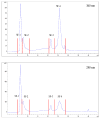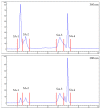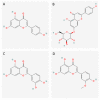Identification of Polyphenols in Sea Fennel (Crithmum maritimum) and Seaside Arrowgrass (Triglochin maritima) Extracts with Antioxidant, ACE-I, DPP-IV and PEP-Inhibitory Capacity
- PMID: 37959005
- PMCID: PMC10650209
- DOI: 10.3390/foods12213886
Identification of Polyphenols in Sea Fennel (Crithmum maritimum) and Seaside Arrowgrass (Triglochin maritima) Extracts with Antioxidant, ACE-I, DPP-IV and PEP-Inhibitory Capacity
Abstract
Sea fennel and seaside arrowgrass are two abundant but underutilized halophytes along the Atlantic and Mediterranean coasts. This study investigated the antioxidant capacity and the potential antihypertensive (Angiotensin Converting Enzyme I, ACE-I inhibition), hypoglycaemic (Dipeptidyl Peptidase IV, DPP-IV inhibition), and nootropic (Prolyl Endopeptidase, PEP inhibition) activity of their polyphenol extracts. They had a high phenol content (21-24 mEq GA/g), antioxidant capacity evaluated using the ABTS (17-2 mg ascorbic acid/g) and FRAP (170-270 mM Mohr's salt/g) assays, and effective ACE-inhibiting properties (80-90% inhibiting activity at final concentration of 0.5 mg/mL). Additionally, the sea fennel extract displayed high DPP-IV inhibitory capacity (73% at 1 mg/mL), while the seaside arrowgrass extract exhibited potent Prolyl endopeptidase inhibitory capacity (75% at 1 mg/mL). Fractionation by HPLC concentrated the bioactive molecules in two fractions, for which the composition was analyzed by LC-MS/MS. Different chlorogenic acids seemed to play an important role in the bioactivity of sea fennel extract, and different flavonoids, mainly apigenin, luteolin and chrysoeriol, in the bioactivity of the seaside arrowgrass extract. Given their potential health benefits, these extracts could serve as valuable bioactive ingredients and could potentially encourage the cultivation of these species in regions where traditional crops face challenges in growth.
Keywords: Crithmum maritimum; Triglochin maritima; angiotensin converting enzyme I; antioxidant; dipeptidyl peptidase IV; halophytes; nutraceutics; polyphenols; prolyl endopeptidase.
Conflict of interest statement
The authors declare no conflict of interest.
Figures




References
-
- Kafi M., Khan M.A. Crop and Forage Production Using Saline Waters. Volume 1 Centre for Science & Technology of Non-Aligned and other Developing Countries (NAM S&T Centre); Daya Publishing House; New Delhi, India: 2008.
-
- Flowers T.J., Galal H.K., Bromham L. Evolution of halophytes: Multiple origins of salt tolerance in land plants. Funct. Plant Biol. 2010;37:604–612. doi: 10.1071/FP09269. - DOI
Grants and funding
LinkOut - more resources
Full Text Sources
Miscellaneous

